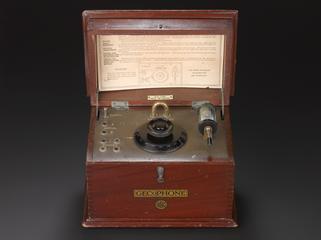
Voigt condenser microphone
- inventor:
- Voigt Patents Limited










Voigt condenser microphone, probably made by Voigt Patents Limited, Sydenham, London, England, 1920-1940.
This type of condenser microphone was known as a 'slack diaphragm' microphone. An oval central pillar with a condensing surface was covered in a thin film of insulating material, followed by an extremely thin (only one thousandth of an inch thick) sheet of metal. It was used for a period by the BBC, but was not as sensitive as other types of microphone. There was also a need to keep this type of microphone very dry which, in combination with the poor sensitivity of the device, meant the slack diaphragm microphone was less popular than other types.
Details
- Category:
- Radio Communication
- Object Number:
- 1960-132
- Materials:
- brass (copper, zinc alloy), metal and foam
- Measurements:
-
overall: 195 mm x 90 mm diameter, .39 kg
- type:
- microphone
- credit:
- Donated by the British Broadcasting Corporation




